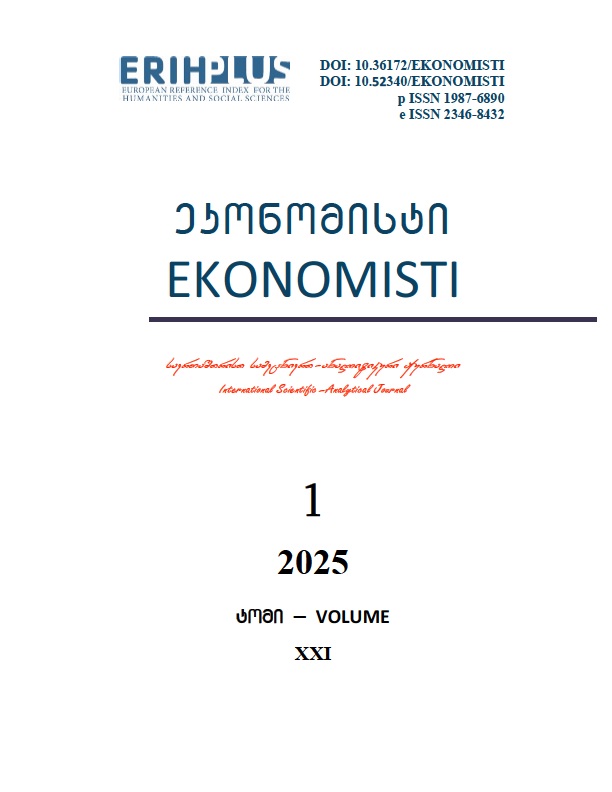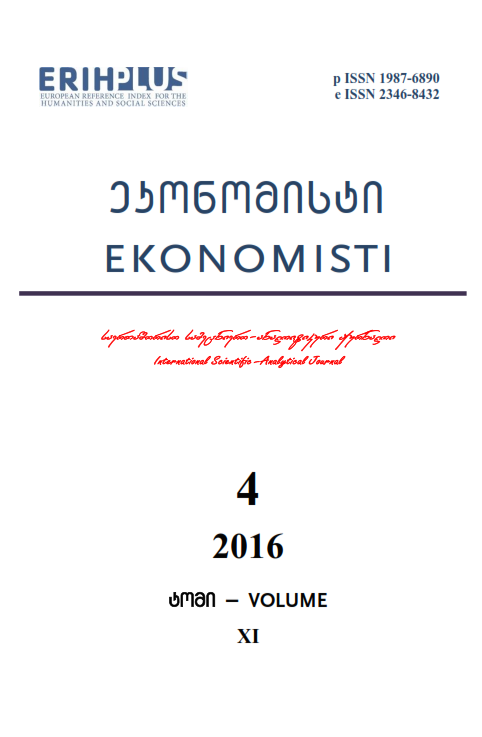
The international scientific and analytical, reviewed, printing and electronic journal of Paata Gugushvili Institute of Economics of Ivane Javakhishvili Tbilisi State University

Analysis of Effectiveness of Monetary and Exchange Rate Policies Using Structural and Bayesian Models
Summary
The aim of this study is to analyze the effectiveness of monetary and exchange rate policies in Georgia. Using structural and Bayesian vector autoregression models study evaluates impact of change in monetary policy rate on inflation, on interest rate on domestic currency loans, on exchange rate and on economic growth.
The main goal of the monetary policy of the National Bank of Georgia is to support price stability and sustain moderate level of inflation, which is an important precondition for achieving sustainable, long-term economic growth. The main instrument of the monetary policy is the monetary policy rate (refinancing rate). Monetary policy influences aggregate demand and inflation through credit, interest rate, exchange rate, expectation and asset price channels. Since monetary policy relies on future economic developments, it reacts to changes in expected inflation. Therefore, it is important to quantify impact of changes in the monetary policy rate on inflation and other macroeconomic indicators and evaluate required time for those impacts to materilize.
Reserachers (Dabla-Norris 2007, Bakradze, Billmeier 2008, Samkharadze, 2008), who evaluated this topic in Georgia prior to adoption of inflation targeting framework, concluded that the transmission mechanism of the monetary policy was weak. In 2013, research conducted by the National Bank of Georgia revealed that the interest rate channel played an important role in the transmission mechanism of the monetary policy, while the exchange rate channel was significant only in the short term. Unlike to the conducted researches, this study uses longer time series, more number of lags, takes into accounts net international investment position as an exogenous variable and evaluates the transmission mechanism using structural and Bayesian vector autoregression models that ensures more credibility of attained results.
To analyze impact of exchange rate on macroeconomic variables research is conducted using structural vector autoregression (SVAR). SVAR (proposed by Sims, 1980) is an extension of traditional vector autoregression (VAR) analysis. It combines economic theory with time series data to quantify impact and response of variables on different shocks or economic policies. Main advantage of SVAR analysis is that it need a minimum of identifying assumptions. Reduced form model can be estimated using restrictions that are based on economic theory. To identify structural shocks in reduced form SVAR model cholesky decomposition is used, which is one of most often used approaches for this analysis. After recovering structural shocks, they can be used to perform impulse response and variance decomposition. Afterwards, it is possible to evaluate impact of shocks to different variables.
To conduct vector autoregression analysis quarterly data from the 1st quarter of 2004 to the IV quarter of 2016 has been used. The model consists of 5 endogenous, 1 exogenous and 1 structural change variables. Endogenous variables are: annual growth rate of real GDP, annual inflation rate, monetary policy rate, interest rate on loans issued in national currency and annual growth rate of nominal effective exchange rate. The exogenous variable is change in the net international investment position that reflects the difference between foreign assets and liabilities of the country. Increase in foreign liabilities is expected to have a positive impact on the economic growth in the short term. While the variable of structural change corresponds to the period of financial crisis, after which the potential growth of the economy decreased (Podpiera, Jiri et al. 2017).
In cholesky decomposition order of variables is important to reflect which variables react to exogenous shock to other variables in the same period. Growth rate of gross domestic product is located on the first place, because it does not adjust to the change of other variables in the same quarter. Respectively, on the following positions are inflation, monetary policy rate, interest rate on domestic currency loans and on the last position is the exchange rate, because it reacts to changes to all other variables in the same period.
According to the results obtained from structural vector autoregression, tightening of monetary policy by 1 percentage point has a significant effect on inflation in 3-4 quarters and reduces it by 1.5 percentage points. This policy is expected to increase interest rate on domestic currency loans by 0.4 percentage points, appreciate exchange rate by 1.6 percent and decline GDP growth by 1.1 percentage points.
The results obtained from Bayesian vector autoregression confirm significant effect of monetary policy on inflation and other macroeconomic variables, although the impact is smaller. Bayesian estimation used in this study is based on well-known paper by Litterman (1986). According to results obtained from this model, tightening of monetary policy by 1 percentage point has a significant effect on inflation in 3-4 quarters and reduces it by 0.4 percentage points. This policy is expected to increase interest rate on domestic currency loans by 0.1 percentage points, appreciate exchange rate by 0.7 percent and decline GDP growth by 0.4 percentage points.
To sum up, obtained results showed that the increase in the monetary policy rate leads to increase in interest rate of domestic currency loans, decrease in economic growth, appreciation of nominal effective exchange rate and decline in inflation rate. This study is concentrated on the analysis of the monetary policy transmission through the interest rate and exchange rate channels. Further studies are required to evaluate other monetary policy transmission channels such as credit, expectation and asset price channels.
Keywords: Monetary policy, monetary policy rate, transmission mechanism, structural vector autoregression (SVAR), bayesian vector autoregression (BVAR)
JEL codes: E52, C32, F31

